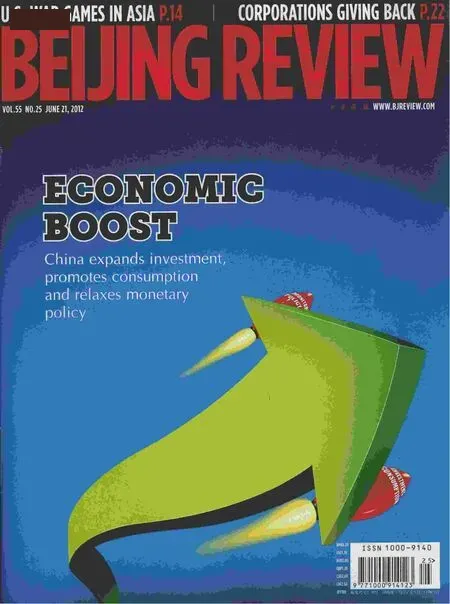MARKET WATCH
MARKET WATCH
OPINION
High Margins Squeezed
The profit margins of Chinese enterprises have been squeezed this year, indicating the terminus of a lucrative era.
The plight confronted by these enterprises is confirmed by numbers. From January to June, the profits of the nationwide industrial enterprises above designated size registered 2.3117 trillion yuan ($366.93 billion), down 2.2 percent from last year. The picture also looks bleak to stateowned enterprises which once featured high margins. Statistics from January to July show that state-owned enterprises (except financial enterprises) nationwide saw profits drop 13.2 percent. Among them, central enterprises earned 823.67 billion yuan ($130.74 billion), down 10.7 percent year on year; local state-owned enterprises earned 376.33 billion yuan ($59.73 billion), down 18.3 percent year on year. The profits of state-owned enterprises have recorded negative growth for seven consecutive months since last year.
For the first seven months, state-owned enterprises saw accumulative revenues up 10.4 percent but profits down 13.2 percent year on year. Among the 41 industrial sectors, 26 sectors witnessed an increase in profits while 13 sectors saw profits shrink; one sector turned losses into gains and one sector reversed from loss-making to profits. As a barometer of the macroeconomy, the stock market is also dispiriting. A total of 992 public companies listed in the stock markets of Shanghai and Shenzhen released their performance forecasts of the first half year, 394 of which would see net profits falling if calculating in maximum changes of net profits.
The plunge of corporate profits is in line with the decline of the Producer Price Index (PPI), which means the profit cycle coincides with the price cycle. PPI in the Chinese market fell by 2.9 percent in July, and the negative growth has continued for five consecutive months, suggesting that the price decline caused by shrinking demand has grown very serious. A declining PPI can alleviate the cost pressure on enterprises and further boost profits, but why is the opposite found to be the case?
First, reduced profits largely result from inventory cost. When the raw material and means of production enterprises use were purchased several months ago and when prices were relatively high, these enterprises would sulk from a sandwich trap and have to deal with pressures from both reduced revenues and high inventory cost. At the same time, considering the likely weak demand in the future, the majority would take a cautious attitude in purchasing raw material, which would further add to weak market demands.
Second, the stickiness of labor costs also contributes to the current profits dip. Besides, in the labor market, wages often rise faster in a boom than they fall in a downturn. Despite that the trend of raising wages has slowed in recent years, labor cost is still a major challenge many companies face.
Last, some sectors are harassed by excess production capacity throughout the industry chain. In the short run, the financial crisis complicated with expanding investments of the last economic cycle seems to be the culprit behind the current production capacity. In the long run, Chinese enterprises should experience an industrial restructuring and change their inefficient pattern of growth. Now, 28 percent of the manufacturing industry is at idle capacity and 35.5 percent of manufacturing enterprises have their rates of capacity utilization below 75 percent. With the current slide of economic growth in both foreign and domestic markets, weak demand in combination with rising costs will undoubtedly lead to a further profits drop. In a word, many sectors are calling for a restructuring of the whole industrial chain.
To deal with the current profits drop, the government should underline the significance of industrial restructuring, eliminate outdated capacity and improve their competitiveness in the market. Meanwhile, efforts should be made to stabilize the shrinking market demand through transformation and upgrading of technology and products. Enterprises need to strengthen their efforts in energy saving and emission reduction, speed up their steps from the lower end to the higher end of the value chain, and promote industrial concentration through nurturing some competitive leading enterprises.
THE MARKETS
Domestic Airplane
On August 27, the seventh Modern Ark 60 introduced by Okay Airways smoothly landed in Tianjin Airport, making Okay Airways the largest operator of domestic-made airplanes.
Okay Airways is the first aviation enterprise to bring in domestic airplanes and put them into commercial operation. On October 19, 2008, Okay Airways’ first Modern Ark 60 completed its successful maiden voyage.
By now, Modern Ark 60 planes have flown more than 20 flight routes and carried 300,000 passengers in Okay Airways. Airlines like Air China, China Southern Airlines, China Eastern Airlines and Hainan Airlines also have begun to order domesticmade airplanes.
Huida’s 30th Anniversary
On August 18, Huida Sanitary Ware Co. Ltd. celebrated its 30th anniversary in Tangshan, north China’s Hebei Province.
In the past three decades, the company has developed into China’s biggest sanitary ware producer with total assets of 1.3 billion yuan ($206.35 million) and more than 10,000 employees. Today Huida’s products are sold in more than 90 countries around the world.
At the celebration ceremony, Huida was formally approved as the National Housing Industrialization Base by the Ministry of Housing and Urban-Rural Development. It is China’s only housing industrialization base in the sanitary ware industry.
The National Housing Industrialization Base is awarded to those enterprises engaged in housing integration including construction, decoration and supporting facilities.
According to the ministry, the country hopes to improve the development level of the country’s construction sector and set up a complete housing industry technical system that saves energy, land, water and materials through the establishment of National Housing Industrial Bases.
Earlier this year, Huida’s new R&D center for electronic sanitary ware was set up in South Korea.
In addition to sanitary ware, Huida will enter into other industries related to housing and construction in the future.
This is an edited excerpt of an article by Zhang Monan, an associate researcher with the State Information
Center, published in the National Business Daily

